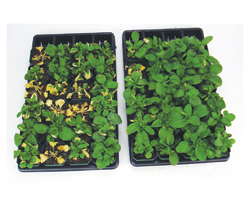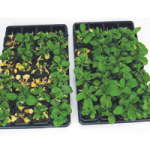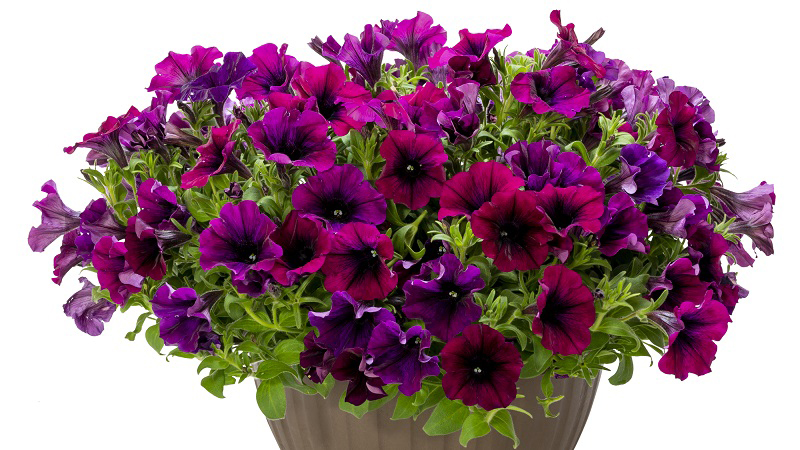A Welcome Side Effect

All growers know that while many things have to go right to get a healthy crop to market, only one thing has to go wrong to ruin it. Usually they know this from painful experience.
Despite careful monitoring of temperature, light, nutrients, moisture and humidity, plus constant attention to the presence of diseases or pests, it only takes one time for an employee to forget to water or for a thermostat to malfunction to make a crop unsaleable.
Plant health management has always been a balancing act with little room for error. The importance of aesthetics over yield in the ornamental industry means consumers will tolerate very little damage to the plants. It goes without saying that plants should be maintained in optimum health to allow them the best chance to resist disease and stress. But more and more, plant researchers are finding that there are actual cellular responses within plants that once triggered, provide an extra boost in a plant’s ability to resist stress and disease.
One of these responses is caused by pyraclostrobin, the active ingredient in Pageant Intrinsic brand fungicide, manufactured by BASF. In fact, the plant response is noticeable enough and repeatable enough that Pageant Intrinsic is the first crop protection product in the ornamental market allowed by the EPA to put “plant health” on the label. It received the plant health label two years ago in the turf market and was the first in that area as well.
“We felt if we were going to say something about a product, then we need to stand behind that claim,” says Kathie Kalmowitz, Ph.D., market development specialist with BASF. “The label is the letter of the law. We chose to show that we have the data to back up what we’re saying.”
Help with Stress Resistance
Pageant Intrinsic is a new tool that can provide some peace of mind to growers in certain situations, primarily in helping plants to weather short periods of stress.
“We actually did quite a few different trials to understand where the significant enhancement to the growth of the plant, the protection of the plant, was,” Kalmowitz says. “In turf we found that the carbons that are being reserved through the respiration process are now being shuttled to the roots. So if you go into a drought, or you go into high heat, those roots are able to take the plant through that stress.”
“In ornamental plants, we thought about it and asked, ‘How is that significant here?’ Again, it was to help the plant get through periodic stress events, like an unanticipated dry down or drought – somebody forgot to water the bench. Or maybe it’s a cold event, where we can actually show that we have protection from cold. That’s where it led us.”
Early research in Germany that showed certain chemical pathways were being turned on by pyraclostrobin, leading to this plant response, plus anecdotal evidence of health benefits inspired further research into specific markets.
“It’s easier to see on the crop side because you’re talking about increased yields and stronger stalks of corn and things that are much more physical and readily apparent to anybody versus the kind of work that we’ve done on the ornamental side,” Kalmowitz says. “So what we had to do was take the basic science knowledge and apply it to the area in which we were working. In ornamental plants, it’s all in the aesthetics – the plant needs to maintain its integrity as it moves through the stress event.”
Shipping is a prime example of a stressful event in which the plant health benefits, along with Pageant’s fungicidal action, can be seen.
“You want the plant to hold up during shipping – to not have yellow leaves or lose any of its flowers, and to be able to weather more extended dryness,” Kalmowitz says. Rebounding from stress is faster too. “Even if a plant wilts down a little bit, it rebounds faster because it has the reserves of carbon that are allowing it to move into that recovery,” she says.
Paul Pilon, owner of Perennial Solutions Consulting, which specializes in commercial greenhouse production, agrees that pyraclostrobin-based products such as Pageant Intrinsic can provide noticeable benefits to plant health.
“I’ve been working with BASF on some of their plant health trials for about two-and-a-half years, and every study where I’ve measured drought or wilting systems – probably half a dozen varieties or so, there’s been an increase in the time before the plants exhibited wilt symptoms on treated plants versus the untreated,” he says.
Pilon has also conducted studies in which plants were subjected to freezing conditions, mimicking those they might experience during frost events or while shipping liners during the winter months.
“There’s enough there to tell me that in many situations there’s a benefit. It’s not completely predictable, and I would say, challenging to repeat. If you look at a frost event, how many times do you get the exact temperature for the same duration? So it might be 26°F this time and 28°F the next time.”
The Biggest Bang for The Buck
Both Pilon and Kalmowitz stress that first and foremost, Pageant Intrinsic is a fungicide and should be used primarily for that purpose.
“It is such a strong fungicide – it provides such excellent protection across a number of different foliar, crown and root pathogens that a grower would definitely want to use it and not disregard that aspect. What we want to do now is guide growers into more wisely putting it into their production rotation so they get the biggest bang for their buck,” Kalmowitz says.
She recommends growers think about when plants might be under more stress during their production cycle and see if they can insert it into the product rotation when it makes the most sense. Pilon echoes Kalmowitz’s sentiment, saying it makes sense to use Pageant Intrinsic in situations when growers can obtain the plant health benefits.
“For instance, a liner producer who boxes up a shipment and might get botrytis in the box – by putting Pageant on prior to that, they’re still using it for the fungicidal properties, but they’re potentially getting all these other benefits,” Pilon says.
Great Results but No Guarantees
Pilon feels that despite the fact that plant health benefits cannot be guaranteed, growers will be receptive to the idea once they learn about the possibilities. “Somehow we have to change the mindset,” he says. “But if the potential benefits are there, many of my clients would jump at the opportunity to increase shelf life, even if it’s only for a few hours of drought tolerance. When you’re working with merchandisers at the retail level, that can be a huge benefit. The whole thing is – here is this great potential for the industry, but nobody can guarantee the results, so how is that going to be interpreted?”
Pilon says while there have been repeatable studies at BASF, he does his trials in grower greenhouses where it isn’t possible to replicate protocols exactly each time.
“There’s so many different variables – environmental factors, temperatures, stresses – prior to going into the cold or drought setting. That’s real life. There are no growers who have the exact same conditions anyway. So even though there are many success stories, there’s no way a company can guarantee it.”
BASF’s Kalmowitz agrees and says the company is focusing on four large product units this year – pansies, petunias, impatiens and geraniums – in its launch of Pageant Intrinsic’s plant health label.
“Because as we continued to put them through trial after trial they always consistently had plant responses that were very notable – less loss of leaves, good flower retention; the integrity of the plant was still marketable,” she says.
Adds Pilon: “The new label is the only one that has the verbage of plant health benefits on there. For the grower, it’s going to open up new possibilities. However, if they’re using it only for these purposes, I think they’re missing the big picture. Fungicide first, and then we have these potential plant health benefits.”
Are there more products coming down the pike that may obtain a plant health label?
“Oh definitely,” says Kalmowitz. “Our Intrinsic brand is an umbrella to new innovations and, of course, our pyraclostrobin-based fungicides are leading the way with that branding. This is a major initiative for us that we will continue to work on for wherever it takes us and how many resources we need to put behind it. Our research hasn’t ended. It’s been fascinating for us – we’re having a lot of fun.”










